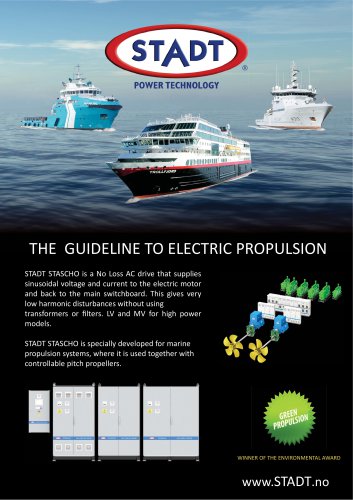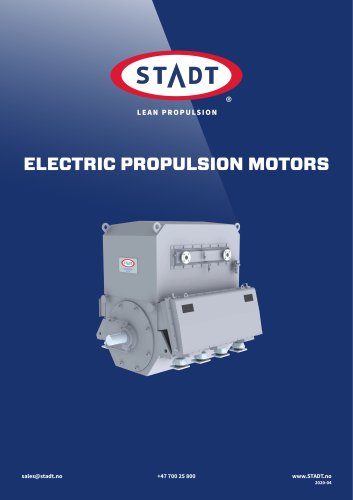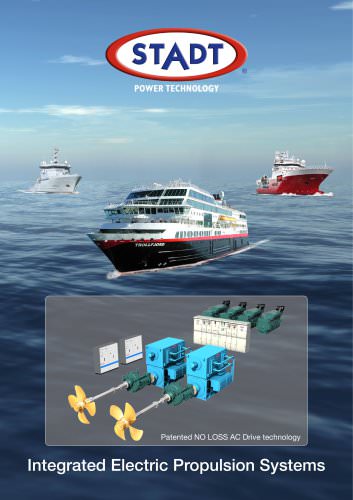
Catalog excerpts

THE GUIDELINE TO ELECTRIC PROPULSION STADT STASCHO is a No Loss AC drive that supplies sinusoidal voltage and current to the electric motor and back to the main switchboard. This gives very low harmonic disturbances without using transformers or filters. LV and MV for high power STADT STASCHO is specially developed for marine propulsion systems, where it is used together with controllable pitch propellers.
Open the catalog to page 1
Choosing The Best Electrical Propulsion System POWER TECHNOLOGY Electric propulsion is a natural choice for a lot of different ship types, and there are many reasons why this solution is so popular. Fuel savings, emission reductions, ECA regulations, redundancy, reduced noise & vibration, low maintenance, space utilization, the use of LNG -electric propulsion are just some of the reasons to choose electric propulsion. These systems can be designed in many ways, with the following main elements: Different prime movers: Typically 3 to 6 in parallel • Dual Fuel • Rechargeable batteries and...
Open the catalog to page 2
Experiencing The STADT No-Loss Ship Type: Seismic Research Vessel, DNV Class, AUTR DP-2 Owner: Sanco Shipping AS - Charted by PGS since 2011 Delivered: October 2009 (Sister vessel MS Sanco Star delivered in 2008) fm—■»! Sanco Spirit has been a very successful ship for its owners and charters since it went in to operation in 2009. The ship's captain, Mr Ronny Muren, and the technical manager at Sanco Shipping, Mr Jon Aklestad both reports that the STADT STASCHO No-Loss electric propulsion technology has proven itself to be extremely reliable over the years. The ship has not gone off-hire at...
Open the catalog to page 3
Todays Electric Ship Technologies How Efficient, Reliable, Predictable and Sustainable are they? POWER TECHNOLOGY
Open the catalog to page 4
Technology in The AC Motor Drive: Sine Wave The use of Sinus vs PWM (Pulse Width Modulation) control technology will lead to many consequences. The sine wave technology is free from electromagnetic noise, while PWM is a powerful noise transmitter that can disturb all kinds of electric equipment on a ship. PWM can also force current to flow through roller bearings in AC motors or gearboxes, with mechanical breakdown as a result. PWM drives needs special screened power cables, while Sine Wave drives can work with unscreened power cables. Number of Electric Energy Transformations in Power...
Open the catalog to page 5
Evaluation Comments POWER TECHNOLOGY Are Redundant Power Units in AC Drive Needed? Most AC drives on the market are made as one compact integrated unit consisting of rectifiers, DC capacitor banks, IGBT inverters, control boards & systems, water cooling items etc. In total, up to 80.000 small and big components plays together in a complex way. If one of these components fails, the drive (and the propeller) will stop working. The STADT STASCHO on the other hand, is one of very few solutions on the market that offers redundant power units, in segregated cabinets that can be located in...
Open the catalog to page 6
MARINE ACCIDENT INVESTIGATION BRANCH FLYER TO THE SHIPPING INDUSTRY RMS Queen Mary 2: The catastrophic failure of a capacitor and explosion in the aft harmonic filter room At 0425 on 23 September 2010, as the passenger liner RMS Queen Mary 2 (QM2) was approaching Barcelona, a loud explosion was heard from the direction of the aft main switchboard (MSB) room. Within a few seconds, all four of the podded propulsion motors shut down. A few seconds later, the vessel suffered an electrical blackout. Thick black smoke was seen to be coming from the aft MSB room. Fortunately, the vessel was clear...
Open the catalog to page 7
STADT STASCHO No Loss AC-Drive for ship propulsion and compressor control POWER TECHNOLOGY A Drive technology that combines RPM control with pitch control. Combines 5 control elements multi speed motor pitch propeller control REDUNDANT DRIVE MODEL ACSUPPLY STADT STASCHO FC SIN 3.1 G1V3 NO LOSS due to bypass switching, BP very lowTHD in main switchboard handles regenerative power compact design no acoustic switching noise easy cabling, unscreened reduced number of active components can operate on very low generator capacity low voltage and medium voltage models 3 RPM modes gives very high...
Open the catalog to page 8
STADT STASCHO AC Drive No Loss Sine Wave System POWER TECHNOLOGY What it typically looks like: STASCHO NO LOSS AC DRIVE ■ STASCHO MO LOSS AC DRIVE No-Loss makes air cooling possible Compact How it is arranged electrically in one of the STADT STASCHO models: REDUNDANT DRIVE How it is working in a propulsion system: Every transformation creates losses, THD & EMC. STADT STASCHO creates no losses, no THD & no EMC.
Open the catalog to page 9
12 Pulse AC Drive - PWM Frequency Converter with Transformer What it typically looks like: HF Filter Big 12-pulse transformer High losses - Needs complex water cooling How it is arranged in a propulsion system: If 1 out of 80 000 components fails, the propeller will stop working. Explosion may easily be the result as well. All electricity is transformed 4 times: AC - AC - DC - PWM - AC Every transformation creates losses, THD & EMC
Open the catalog to page 10
AFE - Active Front End Drive PWM What it typically looks like: Optional transformer High losses - Needs complex water cooling How it is arranged in a propulsion system: If 1 out of 150 000 components fails, the propeller will stop working. Explosion may easily be the result as well. All electricity is transformed 4 or 5 times: (AC) - AC - PWM - DC - PWM - AC Every transformation creates losses, THD & EMC
Open the catalog to page 11
Technology Comparison POWER TECHNOLOGY Competitors technology SPECIAL CABLE Competitors technology SPECIAL CABLE SPECIAL CABLE Huge differences: TRANSMISSION LOSSES ECONOMICAL LIFETIME MTBF, MTTR VOLUME, WEIGHT Electric and acoustic noise Bearing currents Voltage stress in motors, Cabelingtype AC versus DC systems - Capacitors PRICE, SERVICE COST
Open the catalog to page 12
STADT STASCHO Propulsion Some basic arrangements for full electric propulsion, base on diesel, LNG or dual fuel using CPP propuellers. Many other options are available. POWER TECHNOLOGY Twin screw - 2 electric motors + 2 small as option Twin screw Twin - 4 electric motors + 2 small as option - 2 twin input gearbox Triple screw - 3 electric motors + small as option Twin screw (Azimuth)
Open the catalog to page 13All STADT catalogs and brochures
-
ELECTRIC PROPULSION MOTORS
2 Pages
-
STADT DN
2 Pages
-
STADT FCU/FCX 400 V
2 Pages
-
STADT FCU/FCX 690 V
2 Pages
-
STADT Sinus M
2 Pages
-
STADT Brochure
8 Pages
-
STADT Product Range
4 Pages
-
STADT STASCHO Product Range
1 Pages
-
STADT MV
3 Pages
-
STADT Vega Drive
1 Pages
-
STADT NFO Sinus
1 Pages
-
STADT Sinus M
1 Pages
-
STADT Penta 400 V
2 Pages
-
STADT Penta 220 V
2 Pages
-
STADT Penta cabinet
2 Pages
-
STADT Brosjyre Low quality
5 Pages
-
Propulsion system
2 Pages
-
STADT PENTA DRIVE
2 Pages
-
Soft Starters
4 Pages
Archived catalogs
-
STADT STASCHO Datasheet
1 Pages
-
Stadt Brochure
5 Pages


























